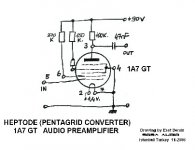Is it Possible 1A7 heptode tube audio preamplifier? Yes.
Here is the link:
http://www.sobavacuumtubeaudio.com/index.php?option=com_content&task=view&id=8&Itemid=7
Here is the link:
http://www.sobavacuumtubeaudio.com/index.php?option=com_content&task=view&id=8&Itemid=7
Miles Prower said:In the first place, that idgit got his types confused. The 1A7 is a dual, large signal diode (somewhat like a 5Y3GT).
?
http://www.mif.pg.gda.pl/homepages/frank/sheets/049/1/1A7GT.pdf
Miles Prower said:Secondly, why would I want to?
Because you've built all the EL84 amps you need.
^^^^
This is the title of your post: 1A7 Heptode (Pentagrid Converter) Audio Preamplifier
This is what appears on the web page linked:
Do you see any "GT" mentioned there?
It's pretty hard to take that seriously. For preamps, there are any number of VTs that'll work much better. These pentagrid types tend to be low on the g(m) since gain isn't the point of the type anyway. Secondly, you have two screens in there for even more partition noise than you'd get from a pentode like the 6AU6. Is the linearity of that better than a 6SN7 or 6SL7, for example?
I could see it for a hollow state version of a SS OTA, or if it were being used for gee-tah FX (compression, tremolo, etc.) but as a preamp, no. Just no.
This is the title of your post: 1A7 Heptode (Pentagrid Converter) Audio Preamplifier
This is what appears on the web page linked:
1A7 Heptode (Pentagrid Converter)
Audio Preamplifier
One of the World
Do you see any "GT" mentioned there?
It's pretty hard to take that seriously. For preamps, there are any number of VTs that'll work much better. These pentagrid types tend to be low on the g(m) since gain isn't the point of the type anyway. Secondly, you have two screens in there for even more partition noise than you'd get from a pentode like the 6AU6. Is the linearity of that better than a 6SN7 or 6SL7, for example?
I could see it for a hollow state version of a SS OTA, or if it were being used for gee-tah FX (compression, tremolo, etc.) but as a preamp, no. Just no.
There is no point bashing another tube artisan's pet project
design philosophy. But I do have to inquire... What the heck
is partition noise? And why might it be higher in a Heptode?
Some folks would rather risk being "wrong" than recycle the
the same old ideas that have been proven a million times.
What comes next, imaginary sigline rules against letting
peas and carrots mix???
design philosophy. But I do have to inquire... What the heck
is partition noise? And why might it be higher in a Heptode?
Some folks would rather risk being "wrong" than recycle the
the same old ideas that have been proven a million times.
What comes next, imaginary sigline rules against letting
peas and carrots mix???
kenpeter said:But I do have to inquire... What the heck
is partition noise? And why might it be higher in a Heptode?
If you have a pentode, you might measure something like: Ip= 10mA; Isg= 2.0mA. These might look like DC values, but they are long term averages. Since the actual electron motion is anything but uniform, over the short term, a big slug of electrons might hit the screen, temporarily raising its current, with a corresponding loss of plate current. The opposite might happen: most electrons miss the screen, reduce its current while raising the plate current. This is "partition noise". It only gets worse with increasing number of screen grids. Pentagrid converters are noisier than pentodes, and may dictate implementing a xcvr mixer differently where low noise is wanted, like below the 40M bands.
Some folks would rather risk being "wrong" than recycle the
the same old ideas that have been proven a million times.
Been wrong lots of times before, and ended up throwing away circuit boards. Stuff happens.
- Status
- This old topic is closed. If you want to reopen this topic, contact a moderator using the "Report Post" button.
- Home
- Amplifiers
- Tubes / Valves
- 1A7 Heptode (Pentagrid Converter) Audio Preamplifier
